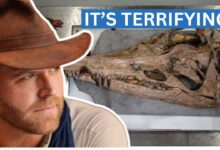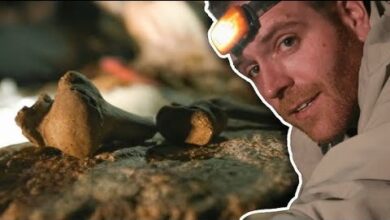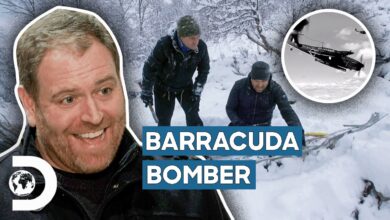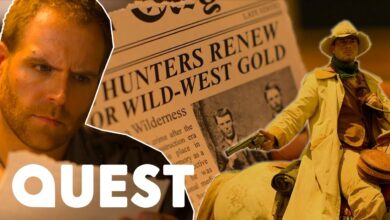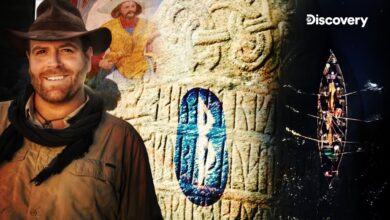Josh Goes Diving in Search of an Old World War II Plane! | Expedition Unknown | Discovery
Josh Goes Diving in Search of an Old World War II Plane! | Expedition Unknown | Discovery

I’m searching for an Avenger torpedo bomber that collided with its wingman and disappeared off of Anacapa Island.
Historian Colin Colburn just made a huge break in the case, unearthing an eyewitness account of where the Lost Avenger went down.
This is kind of a smoking gun.
If this is accurate, then 400 yards out on that bearing, there should be a lost World War Two plane right out there.
400 yards offshore.
So where does that leave us?
Well, from here, we can actually test the accuracy of these eyewitness reports.
And we can do that because we know where Buckley’s plane is.
Right.
We have a baseline sitting out there.
Absolutely diving.
The known wreck may help us solve the mystery of the Lost Avenger.
Does the distance from shore and bearing off the lighthouse match the Coast Guard account?
And is the damage to the tail of the plane consistent with Buckley’s description of the collision?
Okay, so we start with the known wreck and then take that data and hopefully find the lost wreck.
That’s the hope.
All right. And to help with that project, Recover has arranged a vessel to take you out there.
Bigger than my kayak.
Slightly bigger than your kayak.
Colin wasn’t kidding.
Project Recover is working off of the research vessel Shearwater.
This 62-foot catamaran was custom built by the National Oceanographic and Atmospheric Administration to conduct mapping and research in the Channel Islands.
We motor out to the coordinates of the known Avenger wreck where I link back up with Project Recover co-founder Eric Terrell and his team on the top deck.
Hey, Josh, let me introduce you to Heidi.
Hey, Data.
Analyst. Nice to meet you.
Pleasure, Andrew.
Our lead archaeologist. Nice to meet you as well.
So. Okay. Directly underneath us should be an Avenger.
That’s correct. Accidentally discovered by divers.
The location of the wreck was officially cataloged by the National Park Service in 1996.
Let’s start by talking about where we are.
Got Anacapa Island right here.
And there’s our lighthouse.
So the report puts the wreck at 300-degree bearing.
Kind of take a look at where we are right here.
We see that the bearing lines up almost perfectly to what the historical report is telling us.
And the distance from the lighthouse.
The distance in the record says 100 yards.
Now, I’m no expert, but we are way more than a hundred yards from that lighthouse.
That’s way more. We are sitting at about 1800 yards from the lighthouse.
Okay. So that’s off by a factor of 18.
Yes. So that’s hugely inaccurate.
Big time. This is really common fog of war, chaos.
The angles are often very accurate.
Distances are generally horribly wrong.
So what does this data tell us about the Lost Avenger on the other side of this island?
It’s probably going to be on an inaccurate bearing on that side, but we probably want to think about moving a greater distance from shore than what the historical record is telling us.
Right.
Because that distance may be just as inaccurate over there.
Exactly. So in terms of the known wreck underneath us, what’s the plan?
Well, we would love to get some imagery.
And if we can get a lot of very high-resolution photographs that overlap in all directions, then we can use photogrammetry, which is a technique that will allow us to align those photos and give us a 3D representation, a model of what the wreck looks like today.
Got it. So get lots of photos of the wreck.
Use that to build a 3D model.
Exactly. And that information will allow us to be able to understand if the crash site really is consistent with the wreck reports.
So, Heidi, you’re diving down or…?
The water’s a little cold.
I think it’s your turn.
Yeah, we’ve only just met, Heidi, but you’re really catching on to how this always goes for me.
I gear up and dive in.
The frigid water bites through my thick wetsuit.
But the real danger of this dive is depth.
The plane rests at nearly 120 feet, which means I only have a limited amount of bottom time before I have to surface to avoid decompression sickness.
I’ve got to make every second count.
Josh, do you copy?
I am my copy, and I am following the anchor line down.
How’s the Viz? How’s the water temp?
Water’s freezing.
Visibility is not great.
Maybe 10 or 15 feet tops.
Not able to see the bottom at this point.
Keep heading down the anchor line.
We’re really close to the wreck.
You should see it right away.
Oh, Josh, I am approaching the bottom.
No sign of the wreck.
Josh, we’re about ten yards from the wreck to the west, so just keep coming.
That direction, and you should find it.
I’ll leave the anchor line and head over that way.
Standby.
Besides a lone crab who is definitely not happy to see me, this place is a desert.
Did we anchor too far off the target?
The clock is ticking.
I have to find this plane.
I got it. I feel a wreck.
Absolutely incredible.
Josh, what’s the condition?
Condition is amazing, actually.
The entire aircraft appears to be here.
Both wings are attached.
You can clearly make out the fuselage.
It’s in great shape, considering what it’s been through.
All right.
Good. Copy. Go ahead and take your photographs.
You’ve got limited time at the bottom.
The thousands of photographs I take will be digitally stitched together to create a 3D model for detailed forensic study.
Topside, the outline of the plane is so clear, but big sections of it are missing.
The whole fuselage section is collapsed in.
Not surprising, given it’s a lot of aluminum and just natural degradation down there.
I’ve circled the plane a couple of times.
I got a grip of photos here.
Hey, Josh, how’s your bottom time?
I’ve only got a couple of minutes left before I’m going to need to start surfacing.
Copy that. Be sure to focus on the tail section if you can.
That’s where it was hit.
Will do.
I’ll take another pass on the tail, and then I’m coming up.
There’s not much left.
It’s really just an impression.
I’ll document everything I can.
As I move in close, I’m struck that this is more than just a wreck.
It’s a memorial.
The pilot and radioman survived the crash, but tail gunner Lawrence Works didn’t make it.
The round impression at the rear of the cockpit is all that’s left of the turret where he sat.
Okay. Topside.
I am headed to the surface.
I’ll meet you at the back of the boat.
Copy that.
After a brief decompression stop on the anchor line, I make my way to the surface.
Hey, Josh, how did the dive go?
Oh, man. Spectacular.
All this talk about these two Avengers.
Where they were.
The men that were in them.
To go down there and see one of them takes the whole thing from story to a piece of history.
Really?
No, I get it. Josh.
Seeing those wrecks in person.
Just really connects you to the site.
Really powerful to see it down there.
Great. Let’s get you on board and let’s start data processing.
While I dry off, Heidi begins rendering the photos of Buckley’s Avenger.
A few hours later, we head inside the cabin to take a look.
Okay, Heidi, what do we got?
Well, you collected a whole bunch of images, and they look amazing.
We got good data.
We did.
It looks really good. You want to see it?
Yes, I’m dying to see it.
Okay, here we go.
After nearly eight decades of silence, the known wreck has a new story to tell, revealing clues that could lead us to the Lost Avenger.
Oh, this is incredible. Look at that.


